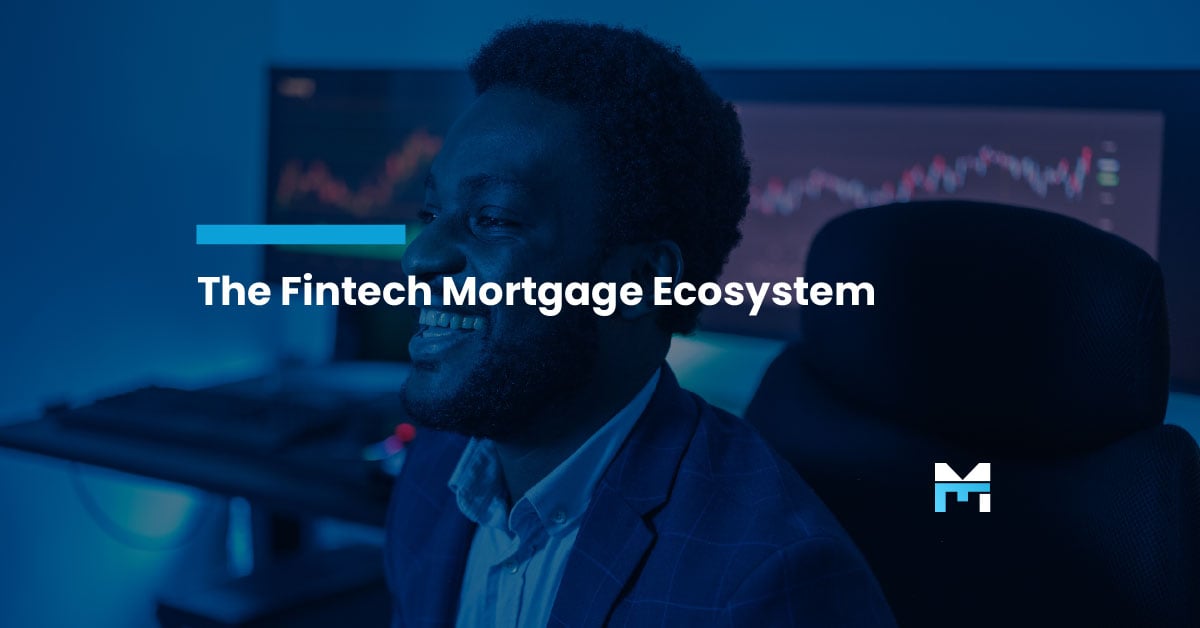How Mortgage Technology Companies Are Saving The Planet (And Your Bottom Line)
Paper trails in mortgage lending once meant literal trails…stacks upon stacks of documents that could fill entire rooms. But what if we told you that
Information Security Compliance
Add security and compliance to Microsoft 365
BI Reporting Dashboards
Realtime pipeline insights to grow and refine your learning operation
Integrations for Banks & Credit Unions
Connect LOS, core platforms, and servicing system
Productivity Applications
Deploy customized desktop layouts for maximum efficiency
Server Hosting in Microsoft Azure
Protect your client and company data with BankGrade Security
6 min read
Justin Kirsch : Oct 21, 2025 10:00:00 AM

The mortgage industry has undergone a remarkable transformation. Gone are the days when securing a home loan meant weeks of paperwork, multiple branch visits, and endless phone calls. Today's fintech mortgage landscape offers something revolutionary: a simple digital experience that connects every touchpoint in the lending ecosystem.
This interconnected web of technology and mortgage solutions doesn't just make life easier for borrowers; it fundamentally reshapes how lenders operate, compete, and thrive in an increasingly digital marketplace. Not so coincidentally, it also helps reshape our own ecosystem and sustainability; read more about that in our blog The Paperless Mortgage Office: From E-Signatures to AI-Powered Document Processing.
Modern borrowers arrive at your digital doorstep with specific expectations. They've researched rates online, compared lenders, and they're ready to move forward…but only if you can match their need for speed and convenience.
Fintech mortgage applications have redefined what's possible. Borrowers can now complete pre-approvals in minutes, upload documents via smartphone cameras, and track their loan status in real-time. This isn't just about digitizing old processes; it's about reimagining the entire borrower experience.
Consider the numbers: 92% of homebuyers now use online methods during their mortgage journey, with over one-third completing applications entirely online. The Federal Reserve Bank of New York's research shows that fintech lenders close mortgages 20% faster than traditional lenders, with significantly lower default rates despite the accelerated timeline.
The smartphone has become the primary interface for mortgage applications. Leading platforms prioritize mobile optimization, ensuring borrowers can easily transition between devices without losing progress. This flexibility proves essential for today's busy consumers who might start an application during their lunch break and finish it at home.
Optical Character Recognition (OCR) technology paired with artificial intelligence transforms document collection from a manual burden into an automated workflow. Borrowers upload W-2s, pay stubs, and bank statements, and sophisticated algorithms extract relevant data points instantly. This automation reduces processing time from days to minutes while improving accuracy.
Transparency builds trust. Modern mortgage platforms provide borrowers with real-time updates throughout the process, eliminating the anxiety of wondering where their application stands. Automated notifications inform borrowers when documents are received, when underwriting begins, and when approval decisions are made.
While borrowers see a smooth interface, the real magic happens behind the scenes, where multiple systems work in harmony to process, verify, and approve loans.
AI-powered underwriting systems analyze vast amounts of data to make lending decisions with remarkable accuracy. Research shows that AI can predict loan acceptance with 85% accuracy and default possibilities with 75% accuracy. These systems don't replace human judgment…they enhance it by identifying patterns and risks that might otherwise go unnoticed.
Machine learning algorithms continuously improve their accuracy as they process more loans. This self-improving capability means that lenders using AI technology become more efficient and effective over time, creating a sustainable competitive advantage.
Blockchain technology addresses two critical challenges in mortgage lending: security and efficiency. Every transaction is recorded on an immutable ledger, creating an unalterable chain of documentation that enhances trust and reduces fraud risk.
Smart contracts automate many routine processes. When specific conditions are met (such as successful income verification or property appraisal completion) smart contracts automatically trigger the next steps in the process. This automation eliminates delays caused by manual processing and reduces the possibility of human error.
Scalable cloud infrastructure enables mortgage lenders to handle fluctuating application volumes without significant infrastructure investments. During refinancing booms or peak buying seasons, cloud-based systems automatically scale to accommodate increased demand, ensuring consistent performance regardless of volume.
The most significant advantage of modern fintech mortgage ecosystems is their ability to integrate disparate systems into cohesive workflows. This integration eliminates data silos and creates optimal information flow throughout the lending process.
Application Programming Interfaces (APIs) serve as the connective tissue between different systems. Modern mortgage platforms built with API-first architecture can easily integrate with credit bureaus, appraisal management companies, title companies, and secondary market investors. This connectivity ensures that information flows smoothly between systems without manual intervention.
Today's mortgage ecosystem includes numerous specialized service providers, from income verification companies to fraud detection systems. Successful platforms integrate these services without interruption, presenting borrowers with a unified experience while leveraging best-in-class solutions behind the scenes.
Microsoft mortgage dashboard platforms exemplify the power of integration. These solutions connect with existing Microsoft Office tools that teams already understand, reducing learning curves while providing powerful analytics and reporting capabilities. Power BI integration transforms raw loan data into actionable insights, while Microsoft Teams integration facilitates collaboration across departments.
The secondary mortgage market has traditionally been a paper-intensive environment, but digital transformation is revolutionizing how loans are packaged, sold, and serviced.
Electronic delivery systems enable lenders to submit loans to government-sponsored enterprises (GSEs) digitally. This eliminates the time and cost associated with physical document handling while reducing the risk of document loss or damage during transit.
AI-powered quality control systems review loan files for compliance issues, missing documents, and potential fraud indicators before delivery to investors. This automated review process identifies problems early, allowing lenders to address issues before they impact investor relationships or regulatory compliance.
Forward-thinking companies are exploring blockchain technology for mortgage-backed securities creation and trading. This technology could provide unprecedented transparency in securitization processes while reducing costs and settlement times.
As technology and mortgage convergence accelerate, regulatory compliance becomes more complex. Regulatory technology (RegTech) solutions help lenders navigate this challenging landscape.
RegTech platforms continuously monitor lending activities for compliance with regulations like the Truth in Lending Act (TILA), Real Estate Settlement Procedures Act (RESPA), and Fair Housing Act (FHA). These systems flag potential violations before they become serious problems, protecting lenders from regulatory penalties.
Advanced analytics platforms analyze lending patterns to identify potential fair lending violations or other compliance risks. This proactive approach enables lenders to adjust their practices before regulators identify problems.
Digital platforms automatically create comprehensive audit trails that document every action taken during the lending process. This documentation proves invaluable during regulatory examinations and helps lenders demonstrate compliance with applicable regulations.
The mortgage industry now features a diverse mix of traditional banks, credit unions, and fintech lenders, each leveraging technology differently to compete for market share.
Pure-play fintech lenders often move faster than traditional institutions because they're not constrained by legacy systems or established processes. Companies like Better.com have demonstrated the power of end-to-end digital processes, achieving remarkable processing speed improvements through AI implementation.
Research from the Federal Reserve Bank of New York shows that fintech lenders originate loans more quickly and with lower default rates than traditional lenders. Their centralized, technology-driven operations create scalability advantages that traditional branch networks struggle to match.
Established financial institutions aren't sitting idle. Many have invested heavily in digital transformation initiatives, partnering with fintech companies or developing proprietary solutions. Their advantage lies in established customer relationships, regulatory expertise, and access to low-cost funding sources.
Rather than viewing fintech as pure competition, many traditional lenders are embracing partnership models. These collaborations combine fintech innovation with established lenders' regulatory expertise and funding capabilities, creating hybrid solutions that benefit both parties.
Successfully implementing fintech mortgage solutions requires strategic planning and careful execution. Organizations that approach digital transformation systematically tend to achieve better results than those attempting wholesale changes overnight.
Begin by mapping your current borrower journey and identifying pain points that technology can address. Focus on improvements that will have the most significant impact on borrower satisfaction and operational efficiency.
Choose solutions that integrate well with your existing systems. The most sophisticated technology won't deliver value if it creates new data silos or requires duplicate data entry.
Technology is only as effective as the people using it. Comprehensive training programs ensure your team can leverage new tools effectively, while change management strategies help address resistance and build enthusiasm for new processes.
Evaluate whether building, buying, or partnering represents the best approach for each technology need. Many successful lenders combine proprietary solutions with best-in-class third-party platforms to create comprehensive ecosystems.
The fintech mortgage ecosystem represents more than technological advancement; it's a complete reimagining of how mortgage lending works. From initial application through secondary market delivery, digital solutions are creating new possibilities for efficiency, accuracy, and customer satisfaction.
The question isn't whether to embrace this transformation, but how quickly and effectively you can implement it. Organizations that act decisively to modernize their operations will capture market share, improve profitability, and deliver superior borrower experiences.
Mortgage Workspace stands ready to guide your transformation journey. Our comprehensive platform integrates smoothly with existing systems while providing the advanced capabilities you need to compete effectively in the digital mortgage landscape. We understand the complexities of modern lending and have the expertise to help you navigate this evolution successfully.
Ready to transform your mortgage operations? Partner with Mortgage Workspace today and discover how our proven solutions can accelerate your digital transformation while maintaining the security, compliance, and reliability your business demands.
1. How long does it typically take to implement a comprehensive fintech mortgage platform?
Implementation timelines vary based on system complexity and integration requirements, but most organizations can achieve basic functionality within 3-6 months and full implementation within 12-18 months with proper planning and project management.
2. What are the primary security concerns with digital mortgage platforms?
Key security considerations include data encryption, access controls, fraud detection, and compliance with regulations like PCI DSS. Leading platforms implement multi-layered security approaches that often exceed traditional paper-based security measures.
3. How do fintech mortgage solutions handle complex loan scenarios that don't fit standard algorithms?
Modern platforms combine automated processing for routine applications with sophisticated workflows that flag complex scenarios for human review. This hybrid approach maintains efficiency while ensuring appropriate oversight for unusual situations.
%20(1).jpg)
Paper trails in mortgage lending once meant literal trails…stacks upon stacks of documents that could fill entire rooms. But what if we told you that

Compliance is, beyond a shadow of a doubt, an essential component of any IT operation. The stakes, however, are even higher in the mortgage industry,...

Sequoia. Lightspeed. Andreessen Horowitz. Every fintech mortgage startup wants that backing. But too many stumble at one overlooked step: technical...